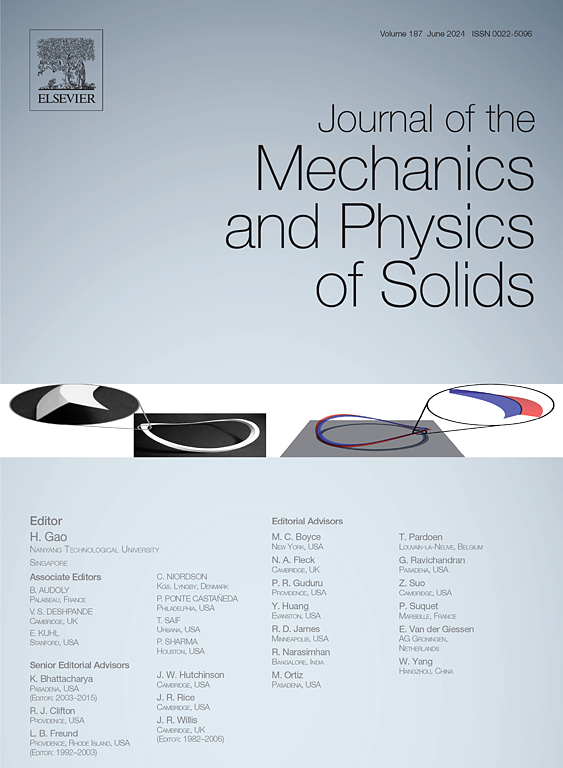竞争表面和体扩散控制下微孔的形态演化和不稳定性
IF 6
2区 工程技术
Q2 MATERIALS SCIENCE, MULTIDISCIPLINARY
引用次数: 0
摘要
了解极端环境(如高温、辐照)下纳米尺度的扩散控制孔洞生长对于预测金属材料的失效至关重要。我们开发了一个微观力学模型,该模型集成了表面扩散、体扩散和非均质应力场,以捕捉微孔的生长、形态演化和聚并。该模型与已建立的分析解进行了验证,证明了较高的可靠性和准确性。利用该模型,我们探索了表面扩散和体扩散在控制空洞形状稳定性和转变方面的竞争性相互作用。我们的研究结果表明,表面扩散促进稳定,圆形或椭圆形的形态,而体扩散,特别是在非均质应力下,诱导各向异性生长和形态不稳定。随着空隙的增大,表面扩散的影响减小,有利于形成越来越复杂的空隙形状。空洞聚结行为进一步反映了这种相互作用:在没有空隙间空位源的情况下,由于空隙间空位浓度梯度的屏蔽作用,仅靠体扩散不足以驱动聚结。相反,表面扩散促进了空洞的合并,其速率随着表面扩散率的增加而增加。当表面扩散明显弱于体扩散时,孔洞生长变得不稳定,微小的表面扰动可以触发微裂纹的形核。这些发现与已有的实验结果非常吻合。总的来说,这项研究提供了对扩散控制的空洞演化的机制理解,并为极端环境下金属的损伤前体提供了有价值的见解。本文章由计算机程序翻译,如有差异,请以英文原文为准。
Morphological evolution and instability of microvoids governed by competing surface and bulk diffusion
Understanding diffusion-controlled void growth at the nanoscale under extreme environments (e.g., high temperatures, irradiation) is crucial for predicting failure in metallic materials. We develop a micromechanical model that integrates surface diffusion, bulk diffusion, and heterogeneous stress field to capture the growth, morphological evolution and coalescence of microvoids. The model is validated against well-established analytical solutions, demonstrating high reliability and accuracy. Using this model, we explore the competitive interplay between surface diffusion and bulk diffusion in governing void shape stability and transitions. Our findings reveal that surface diffusion promotes stable, circular or elliptical morphologies, whereas bulk diffusion, especially under heterogeneous stress, induces anisotropic growth and morphological instabilities. As voids grow, the influence of surface diffusion diminishes, facilitating the formation of increasingly complex void shapes. Void coalescence behavior further reflects this interplay: in the absence of inter-void vacancy sources, bulk diffusion alone is insufficient to drive coalescence due to shielding effect on vacancy concentration gradient in the inter-void region. In contrast, surface diffusion facilitates void coalescence, with the coalescence rate increasing at higher surface diffusivity. When surface diffusion is substantially weaker than bulk diffusion, void growth becomes inherently unstable, and minor surface perturbations can trigger the nucleation of micro-cracks. These findings show excellent agreement with existing experimental results. Overall, this study provides a mechanistic understanding of diffusion-controlled void evolution and offers valuable insights into damage precursors in metals subjected to extreme environments.
求助全文
通过发布文献求助,成功后即可免费获取论文全文。
去求助
来源期刊
CiteScore
9.80
自引率
9.40%
发文量
276
审稿时长
52 days
期刊介绍:
The aim of Journal of The Mechanics and Physics of Solids is to publish research of the highest quality and of lasting significance on the mechanics of solids. The scope is broad, from fundamental concepts in mechanics to the analysis of novel phenomena and applications. Solids are interpreted broadly to include both hard and soft materials as well as natural and synthetic structures. The approach can be theoretical, experimental or computational.This research activity sits within engineering science and the allied areas of applied mathematics, materials science, bio-mechanics, applied physics, and geophysics.
The Journal was founded in 1952 by Rodney Hill, who was its Editor-in-Chief until 1968. The topics of interest to the Journal evolve with developments in the subject but its basic ethos remains the same: to publish research of the highest quality relating to the mechanics of solids. Thus, emphasis is placed on the development of fundamental concepts of mechanics and novel applications of these concepts based on theoretical, experimental or computational approaches, drawing upon the various branches of engineering science and the allied areas within applied mathematics, materials science, structural engineering, applied physics, and geophysics.
The main purpose of the Journal is to foster scientific understanding of the processes of deformation and mechanical failure of all solid materials, both technological and natural, and the connections between these processes and their underlying physical mechanisms. In this sense, the content of the Journal should reflect the current state of the discipline in analysis, experimental observation, and numerical simulation. In the interest of achieving this goal, authors are encouraged to consider the significance of their contributions for the field of mechanics and the implications of their results, in addition to describing the details of their work.

 求助内容:
求助内容: 应助结果提醒方式:
应助结果提醒方式:


